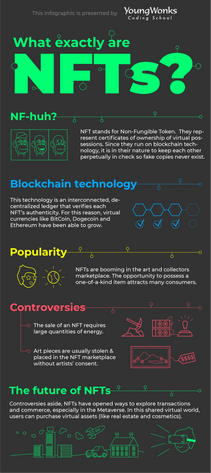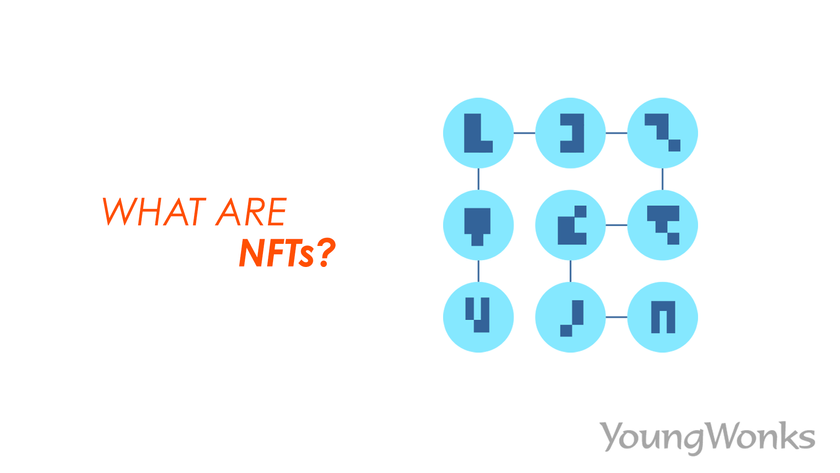Jun 04, 2021 By Team YoungWonks *
What is an NFT? Many have had this question on their mind in a year that has seen bitcoin, blockchain and NFTs bag considerable media attention. This blog then attempts to make sense of what NFTs are and how they are related to blockchain technology. To understand what the latter stands for, check out our blog post on blockchain here: https://www.youngwonks.com/blog/What-is-Blockchain-Technology.
Now let’s look at NFTs. Below is an infographic giving you a quick lowdown on the subject; read on to know more... 
What is an NFT?
NFT stands for non-fungible token. Now what does being non-fungible mean? Fungibility refers to the ability of a commodity or asset to be easily swapped for another of the same kind. So for instance, money is fungible in that a $1 bill can be interchanged with four quarters or ten dimes. Cars and homes are however non-fungible; here the units cannot be interchanged. If person B borrows a car from Person A, the former can’t return a different car, even if it is the same make and model as the original car.
Today, non fungible tokens are, in a manner of speaking, one-of-a-kind trading cards. They can also be digital assets representing real-world objects such as a piece of art, music/ audio, in-game items, videos and other digital files (including, say memes and crypto art, a category of art related to blockchain technology). These assets are bought and sold online, often with cryptocurrencies, and they are highly likely to be encoded with the same underlying software as many cryptos. Such NFTs are basically units of data stored on the digital ledger that is blockchain which in turn certifies it as a unique digital asset. Since they live on a blockchain network - most often Ethereum - NFTs can be easily tracked and this in turn allows for verification of their authenticity along with their past history and owners. In a sense, NFTs are smart contracts each of which come with a certificate of authenticity.
Interestingly, NFTs have been around since 2014, but they are now grabbing headlines like never before. This is because there has been a craze surrounding them of late, especially around buying and selling digital artwork. It is reported that since November 2017 a whopping $174 million has been spent on NFT real estate. In fact, many of these non fungible tokens are being sold by renowned auction houses such as Christie’s and Sotheby’s.
What’s most interesting is that typically digital creations are in abundant - even infinite - supply. Several NFTs one sees today are in fact digital creations that already existed in some form earlier. Think secure versions of digital art already doing the rounds on Instagram or Pinterest (a one-of-a-kind edition of the iconic GIF Nyan Cat being sold as a unique piece of crypto art also comes to mind) or even iconic video clips from FIFA World Cup games and CryptoKitties, a blockchain game on the Ethereum network. An eye-catching example would be when a composite of 5,000 daily drawings by famous digital artist Beeple (real name Mike Winklemann), titled “EVERYDAYS: The First 5000 Days,” fetched $69.3 million at Christie’s. Given that anyone can view individual images or the collage for free online, one may wonder what justifies such a high price for its NFT. The answer lies in the fact that this NFT lets the buyer own the original item which also comes with built-in authentication acting as proof of ownership. So as a collector one gets digital bragging rights.
The same kind of bragging rights apply to the owner of Twitter founder Jack Dorsey’s first-ever tweet who purchased the 2006 tweet as an NFT in March this year (2021) for the princely sum of $2.9 million.
NFT vs Cryptocurrencies
NFTs are digital tokens created using the same kind of programming as cryptocurrencies like Bitcoin or Ethereum (or even Dogecoin). However, it is important to bear in mind that physical money and cryptocurrencies are fungible, in that they can be traded or exchanged for one another. Plus, they’re equal in value; just like one dollar is worth another dollar, one Bitcoin is always equal to another Bitcoin. In fact, this fungibility has facilitated smooth transactions on the blockchain.
NFTs, on the other hand, bear digital signatures distinguishing them from other units of the same kind. Thus NFTs cannot be exchanged for or equal to one another. One clip of a FIFA World Cup match is not the same as another clip even if they’re both NFTs.
How do NFTs work?
NFTs, being digital tokens, are stored on the distributed public ledger called blockchain, which keeps records of transactions. And while many blockchains support them, usually they are held on the Ethereum blockchain.
So the following digital items - representing both tangible and intangible goods - can be used to create or mint NFTs: art works (photos, paintings, GIFs, videos (especially sports highlights), collectibles, virtual avatars, video game skins, designer sneakers, music and even celebrity tweets.
Exclusive ownership rights is another key trait: any NFT can have only one owner at a time. Given their unique data - remember they are stored on the blockchain - one can easily verify and transfer their ownership. The owner or creator can even choose to store specific information inside them. For example, an artist can sign his / her artwork and include their signature in the NFT’s metadata.
This means for all practical purposes, NFTs are collector’s items, except they are in the digital format. So the buyer gets a virtual file as opposed to an actual oil painting that can be hung on the wall.
Where are NFTs used?
The creation and storing of NFTs using blockchain technology has paved the way for artists and content creators to monetize their work in a unique fashion. For instance, an artist doesn’t have to depend on a gallery or auction house to sell his / her works anymore since he/ she can decide to cut out the middleman and sell it directly to the end buyer as an NFT. This means the artist gets to pocket greater profit. Moreover, royalties can be programmed into these works so the creators continue to get a percentage of sales whenever their work changes ownership.
Using NFTs to raise money for a charitable cause is also catching on these days. Taco Bell, for example, sold its NFT art at record bids.
Celebrities like Lindsay Lohan and Snoop Dogg are using NFTs as a platform to sell their unique memories, artwork and moments. Sports videos too make for attractive NFTs; NBA Top Shot is reported to have fetched more than $500 million in sales by March this year, including a video clip of LeBron James's dunk being sold for $208k. Memorable instances basically lend themselves very well to the NFT format.
How to buy an NFT
If you wish to own an NFT, you need to first get a digital wallet that lets you store NFTs and cryptocurrencies. Next step would be to buy some cryptocurrencies, like Ether. It is important to bear in mind what cryptocurrencies are being accepted by the NFT creator/ provider. Cryptocurrencies can be purchased using a credit card on platforms such as Coinbase, Kraken, PayPal, Robinhood and eToro. One can then move it from the exchange to one’s digital wallet. These exchanges also charge a percentage of the transaction as fees at the time of buying crypto.
Once one has sorted out one’s cryptocurrencies, one can turn to any of the NFT marketplaces such as Nifty Gateway, OpenSea.io (known for its rare digital collectibles), Rarible (known for artworks) and Foundation (where artists need “upvotes” or an invitation from fellow creators to post their art).
It is advised to do thorough research before buying an NFT especially given the high prices in the NFT market; one should look out for impersonators. Plus, the verification processes for creators and NFT listings aren’t standard across platforms so buyers need to know what they are getting into.
Real Estate as NFTs?
It turns out virtual real estate is also catching on now as an NFT. A recent Bloomberg report cites information from https://www.nonfungible.com/ to state that virtual plots of land in Decentraland (a virtual reality platform based on blockchain technology) are now fetching more than thrice the amount they were last year (2020), with the average price being paid for land now hovering around US$2,703.
At the end of the day, buying and selling NFTs is a primarily personal decision. And accordingly, an NFT’s value pretty much depends on what someone else is willing to pay for it. Therefore, demand will be the key determining factor over fundamental, technical or economic indicators. So an NFT may resell for less than one originally paid for it or it may not have any takers at all. Additionally, NFTs are subject to capital gains taxes.
The bottom line is this: The future of NFTs is uncertain and there is not a lot of history to gauge their performance either. This makes NFTs a risky proposition as of now and it is recommended to invest small amounts to try it out for now.
Exploring the World of NFTs Through Coding
In the fascinating realm of non-fungible tokens (NFTs), understanding the underlying technology becomes a thrilling adventure, especially for the younger generation keen on decoding the digital age's mysteries. At YoungWonks, through our comprehensive Coding Classes for Kids, we lay down the digital literacy foundation essential for grasping complex concepts like NFTs. Our Python Coding Classes for Kids introduce the programming language at the heart of many blockchain applications, including those used to create and manage NFTs. Simultaneously, our Raspberry Pi, Arduino and Game Development Coding Classes equip students with the hands-on skills necessary to understand how hardware can interact with blockchain technology, opening a world where digital creations can be as unique and valuable as their physical counterparts.
*Contributors: Written by Vidya Prabhu; Lead image by: Leonel Cruz

